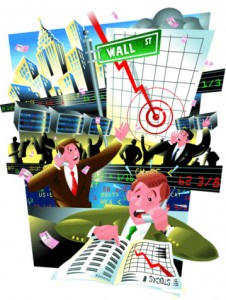The Markets are Mad: Is High-Frequency Trading Making Things Worse?

(liquidlibrary)
Thursday’s 423-point gain by the Dow marked the first time ever that the industrial average has posted four consecutive days of 400-point moves. Less than two weeks into August, there have already been six trading days that saw triple-digit swings this month. While the recent sell-off has been swift (the Dow is off more than 12% since July 21), it’s also been choppy. Volatility is back in a big way. The VIX Index, also known as the fear index, has shot up recently, nearly doubling over the last week. The VIX tracks the expected price of a range of protective S&P 500 options over the next 30 days.
While your average investor generally hates volatility, there are those who feed off it, namely high-frequency traders. These are the guys who use complex algorithms and super-fast computers to scour the markets for tiny price differentials, often executing trades in microseconds (one millionth of a second). The more volatile the market, the easier it is for them to make money jumping in and out of stocks across exchanges.
Now, it’s not quite fair to lump all high-frequency traders together. They don’t all necessarily do well in volatile markets. While some are killing it, there are certainly others who’ve been getting killed; it all depends on their strategy. But generally, traders need two things: 1) a price, and 2) movement. Recently, they’ve had plenty of both.
Ever since last year’s Flash Crash, there’s been a debate brewing over the utility of high-frequency trading. That debate’s gained steam this week, with some claiming the practice makes things worse, and others coming to its defense. While proponents of high-frequency trading say it adds liquidity to markets, and lowers the costs of trading by tightening bid-ask spreads, critics say it creates volatility for its own sake, turning what would typically be small prices changes into wild swings. There’s also a growing sense that it’s bad for the overall economy.
A pair of recent academic papers have taken a long look at the pros and cons of high-frequency trading, and together paint a not-so-nice picture. On Monday, as the Dow was plunging 634 points, a trio of researchers (Ilia D. Dichev and Dexin Zhou of Emory University, and Kelly Huang of the University of Alabama) presented their new paper, “The Dark Side of Trading,” at an accounting conference in Denver. Here’s the full version, and here’s the abstract:
This study investigates the effect of high trading volume on observed stock volatility. The motivation is that volumes of U.S. trading have increased more than 30-fold over the last 50 years, truly transforming the marketplace. Given existing work that links volume and volatility as simultaneously driven by fundamental information, we are specifically interested in the effect of increased trading controlling for such information. We investigate a number of settings, including a mix of natural experiments (exchange switches, S&P 500 changes, dual-class shares), the aggregate time-series of U.S. stocks since 1926, and the cross-section of U.S. stocks during the last 20 years. Our main finding is that, controlling for other factors, there is a reliable and economically substantial positive relation between volume of trading and stock volatility. The conclusion is that stock trading produces its own volatility above and beyond that based on fundamentals.
The paper concludes that while “low to medium” levels of trading can have market-wide benefits, there comes a point at which the huge amount of volume that high-frequency trading adds make the markets so volatile that “only a small circle of traders” truly benefit.
The second paper, titled simply “High Frequency Trading,” comes from Bruno Biais of the Toulouse School of Economics, and Paul Woolley, of the London School of Economics. It ends at a more sinister conclusion. In a section titled “The Darker Arts” the authors claim that high-frequency traders “may also engage in forms of market manipulation,” such as placing spoof orders, which, as explained in a recent Economist article, “are designed to scare gullible traders into offloading their own shares, at which point the HFT investors withdraw their own spoof trades and snap up the real ones.”
Surely, the debate will continue over the merits (or lack thereof) of high-frequency trading. One thing though is clear: now that the practice accounts for somewhere between two-thirds and three-quarters of all equity trading volume, getting rid of it doesn’t appear to be an option. In the words of Dan Patrick, we can’t stop it, we can only hope to contain it.

Comments